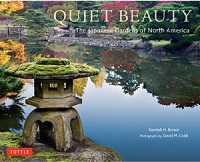
“Quiet Beauty: The Japanese Gardens of North America” is itself a book of quiet beauty, and an excellent introduction to Japanese-style gardens throughout Canada and the United States. Photographer David Cobb, from Mosier (near Hood River), Oregon, is particularly adept at emphasizing the contrasts between light and shadow, the subtle reflections in still waters, and the energy of moving water in his subjects. I have visited many of the 26 featured gardens and he captures the spirit of these very well.
Text author Kendall Brown is an Asian Art historian at California State University, Long Beach. His introductory essay places these gardens in the context of what he sees as five distinctive, historical periods beginning at the end of the 19th century. The Seattle Japanese Garden, along with gardens in Portland, at the University of British Columbia, and at the Bloedel Reserve on Bainbridge Island, are all placed in the second of these periods, a time of “Building Bridges” following World War II.
Feeling regional pride, I read the chapter on this period first, and I wasn’t disappointed. Brown is good at telling (what are often) convoluted histories. He underscores the importance of our local gardens in the development of the Japanese style in North America: “The Seattle Japanese Garden also set a new standard as the earliest major permanent garden built in North America by well-established designers from Japan.” He further compliments it as being “…arguably one of the finest in North America.”
Featured in a later chapter is Spokane’s Nishinomiya Garden in Manito Park, while another ten gardens from throughout Washington (including the Kubota Garden) and British Columbia are briefly described in the appendices, making this an important garden book for the Pacific Northwest. Brown’s earlier (1999) book, “Japanese-Style Gardens of the Pacific West Coast”, is also worth reading for a more in-depth general history of this style.
Excerpted from the Fall 2013 Arboretum Bulletin.